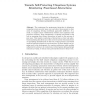PUC
2000
14 years 2 days ago
2000
Much of the ongoing research in ubiquitous computing has concentrated on providing context information, e.g. location information, to the level of services and applications. Typic...
COMPUTER
2004
14 years 4 days ago
2004
The growth of ubiquitous computing has given rise to a range of possibilities for context-based application development. Technologies for mobile computing and context-awareness can...
CACM
2005
14 years 6 days ago
2005
This paper presents a set of architectures for the composition of ubiquitous computing applications. It describes research that is being carried out in "extrovert-Gadgets&quo...
IJWET
2007
14 years 6 days ago
2007
: Context-aware ubiquitous computing environments tend to be highly distributed and heterogeneous, while also featuring increased dynamism as elements, devices and middleware compo...
IJISEC
2007
14 years 6 days ago
2007
The vision of ubiquitous computing is becoming a reality thanks to the advent of portable devices and the advances in wireless networking technologies. It aims to facilitate user ...
IJIPT
2007
14 years 6 days ago
2007
: This paper presents the ANS architecture that uses ubiquitous computing to monitor medical patients in the home. Since there is no notion of the patient carrying out maintenance ...
SAC
2006
ACM
14 years 6 days ago
2006
ACM
Ubiquitous computing places humans in the center of environments saturated with computing and wireless communications capabilities, yet gracefully integrated, so that technology r...
PUC
2006
14 years 7 days ago
2006
This paper describes a taxonomy for a ubiquitous computing software stack called UbiqStack. Through the lens of the UbiqStack taxonomy we survey a variety of subsystems designed to...
PUC
2006
14 years 7 days ago
2006
The requirement for spontaneous interaction in ubiquitous computing creates security issues over and above those present in other areas of computing, deeming traditional approaches...
JUCS
2006
14 years 8 days ago
2006
: Ambient Intelligent (AmI) vision is a new concept materialized by the Six Framework Program of the European Community. It involves three key technologies: Ubiquitous Computing, U...






